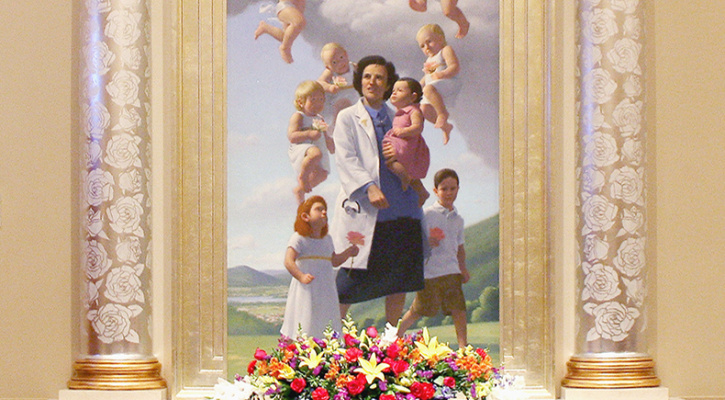PAINTING: St. Benedict by Giambattista Piazzetta, c. 1750 [Church of San Nicolò al Lido, Venice]
By Howard Kainz, The Catholic Thing, Aug. 19, 2017
![]() We hear much these days about the “Benedict Option,” inspired by Rod Dreher’s book by that name. Some Catholics surrounded by “nones” and liberals – and confronting public schools sexualizing students, local parishes preaching a watered-down hand-holding Catholicism, etc. – are seeking various forms of community as a defense against anti-Christian currents.
We hear much these days about the “Benedict Option,” inspired by Rod Dreher’s book by that name. Some Catholics surrounded by “nones” and liberals – and confronting public schools sexualizing students, local parishes preaching a watered-down hand-holding Catholicism, etc. – are seeking various forms of community as a defense against anti-Christian currents.
Some have changed parishes or neighborhoods, or even moved their families to locations bordering Benedictine monasteries! Some may find thecatholicthing.org and similar Catholic Internet sites to be their “cyberspace” Benedict Option.
The general idea is to take steps of self-preservation in a world imbued with relativism and secularism, get support from like-minded persons, and keep ourselves and our children from succumbing to a social environment gone berserk.
Rod Dreher got the inspiration for his book from a short final paragraph of Alasdair Macintyre’s 1981 book, After Virtue, where Macintyre concludes, comparing our age with the late Roman Empire of the original Benedict, “this time . . . the barbarians are not waiting beyond the frontiers; they have already been governing us for quite some time. And it is our lack of consciousness of this that constitutes part of our predicament. We are waiting not for a Godot, but for another – doubtless very different – St. Benedict.”
In a later interview, Macintyre confided that he regretted writing that paragraph, thus giving rise to the impression that he was advocating a strategy of withdrawal.
Macintyre’s book received – and deserved – a lot of attention. I came across it at a time when I was doing research for my book Ethics in Context, and was impressed by his brilliant critique of attempts to formulate viable ethical theories in the aftermath of the Enlightenment – especially two theories that still appear in college classrooms in various revisions and reincarnations: utilitarianism and Kant’s categorical imperative.
One thing, however, that Macintyre does not go into: both of these influential theories were Enlightenment attempts to replace natural-law theory, which had previously enjoyed pride of place among Catholic philosophers and also some Protestant philosophers.
Jeremy Bentham (1748-1832), the father of utilitarian ethics, claims it’s the solution to the “subjectivism” of natural law:
A great multitude of people are continually talking of the Law of Nature; and then they go on giving you their [personal] sentiments about what is right and what is wrong; and these sentiments, you are to understand, are so many chapters, and sections of the Law of Nature. . . .[The “Natural Law” consists] in so many contrivances for avoiding the obligation of appealing to any external standard, and for prevailing upon the readers to accept of the author’s sentiment or opinion as a reason, and that a sufficient one, for itself.
As a solution to the necessity for completely objective “external standards” for ethics, Bentham offers his “utilitarian” system, geared to the maximizing of happiness for the greatest number, and consisting of elaborate charts with numerical ratings of pleasures to be taken into calculation. Later utilitarians have refined Bentham’s quaint charts, and expanded his notions of happiness.
Immanuel Kant (1724-1804) proposed a different replacement for natural law, which involved a return to subjectivism, but seemingly also establishes universal validity with the Categorical Imperative:
Since the universality of the law according to which effects are produced constitutes what is properly called nature in the most general sense (as to form) – that is, the existence of things so far as it is determined by general laws – the imperative of duty may be expressed thus: Act as if the maxim of thy action were to become by thy will a universal law of nature.
In other words, if you want to follow the “law of nature,” simply formulate your moral maxims in such a way as you would wish them to become universalized; if you can’t do this, you are departing from the natural law. (This approach is similar to the Golden Rule, “do unto others,” but, Kant claims, offers a more solid philosophical formulation.)
Macintyre’s critique was a major catalyst for my own interest in natural law, which has been ignored or “replaced” by modern ethicists.
But why is natural-law theory largely ignored by contemporary ethicists? Because of the “is-ought” distinction emphasized by David Hume (1711-76). This is still a “gold standard” among contemporary ethicists. Hume’s distinction (“Hume’s Guillotine”) prohibits any derivation of an “ought” from something factual, like human nature. The Catholic philosophers John Finnis and Germain Grisez have tried to develop a “New Natural Law” theory, which avoids this “Guillotine.” But many others – myself included – find these efforts unconvincing and even unnecessary, due to fallacious interpretations of Hume.
Macintyre does not examine natural law in After Virtue, but does consider the Thomistic version of natural law in Volume 2 of Ethics and Politics. In Chapter 4, “Aquinas and the Extent of Moral Disagreement,” he focuses on Aquinas’ classic analysis (ST Ia-IIae 94, 2) of the three “precepts” of natural law: preservation of our lives and health; education and nurture of our offspring; and pursuit of the truth and rational social relations.
Macintyre also discusses the “secondary precepts” related to Aquinas’ “primary” precepts, and the practical disagreements that occur regarding applications. He concludes that “the set of precepts conformity to which is a precondition for shared rational enquiry as to how our practical disagreements are to be resolved has the same content as those precepts that Aquinas identified as the precepts of natural law.”
A remarkable conclusion: In shared attempts to establish preconditions for dealing with value disagreements, we will arrive at the vestibule of Aquinas’ classical precepts!
We may possibly take this vision of dedicated dialogue as Macintyre’s own new, highly intellectualized, version of the “Benedict option.”
According to this line of argument, ethical contenders establish methodological precepts for overcoming disagreements, and eventually (and surprisingly) arrive willy-nilly at Aquinas’ three precepts about self-preservation, care of offspring, and rationality.
Alistair Macintyre’s brilliant critique of the various attempts in modern philosophy to arrive at “rules” for determining what is ethically right or wrong has been a major stimulus in recent decades for the rise of “virtue ethics.”
Virtue ethics generally avoids attempts to come up with rules governing specific ethical issues, but focuses on virtues, “habits of excellence,” which should lead to proper decisions and activities for good men. De-emphasis and even disdain of specific rules is common among “virtue ethicists.” The focus on virtue by some virtue ethicists is reminiscent of persons who are “spiritual but not religious” – claiming to pursue the spirituality which is the common goal of most religions, but disdaining the rules of particular religions for promoting spiritual progress.
But, as I have indicated in a previous column, following Aquinas’ almost self-evident primary precepts of natural law supplies reliable guidance for countless everyday ethical issues that come up (and also promotes virtue). These precepts may emerge after lengthy dialogues by sincere intellectuals, as Macintyre proposes. But why cannot preservation of life, nurture of offspring, etc. function as starting points for such discussions?







